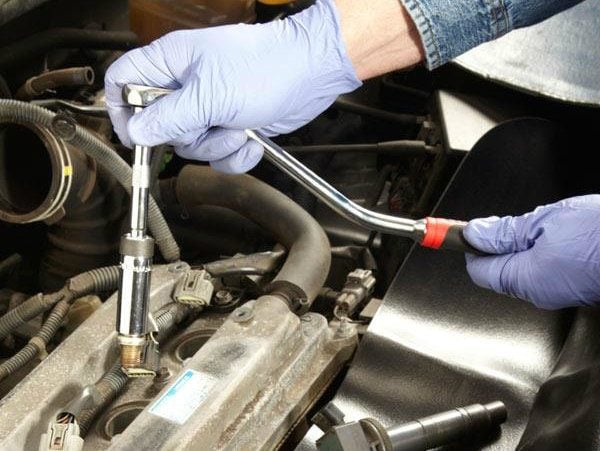
Replacing Spark Plugs: Step-by-Step Instructions
Tools and materials needed:
– Socket/ratchet set
– Needle-nose pliers
– Rags
– Spark plugs
– Anti-seize compound
You already know that spark plugs wear out. Well, “burn up” is more like it, because when a spark jumps the gap between two electrodes, it actually burns off (erodes) minute amounts of metal from each one. Over time, the gap grows to the point where the spark can no longer make the jump. That’s when you get misfires, poor gas mileage, lousy acceleration and, ultimately, the dreaded “Check Engine” light.
To keep vehicles running at peak performance for longer service intervals, many car manufacturers install extended-life spark plugs. Because their electrodes are coated with precious metals that have higher melting points, these plugs can sometimes maintain a precise gap for up to 160,000 kilometres. But even with higher melting points, metals like yttrium (1,526 degrees C), platinum (1,772 degrees C) and iridium (2,443 degrees C) can’t stave off erosion forever. The electrodes eventually erode, increasing the gap, and, well, you’ve already heard the rest of this story.
If you’ve changed your own spark plugs in the past but are intimidated by the newer-style coil-on-plug (COP) ignition systems (pretty much the standard since 2000), it’s time to reconsider.
COP systems may look complicated, but they’re actually easier to work on than the older, distributor-based systems. Sure, you’ll have to learn a few new tricks, but the basics are still the same.
Changing your own spark plugs takes about an hour (for a four-cylinder engine) and will save you at least a hundred bucks in labour. You can use the same old tune-up tools (ratchet, spark plug socket and gap gauge). You should use a torque wrench to tighten the plugs. But there’s a way to get around that if you don’t have one. Just follow these steps and you’ll be tuned up in no time.
Replacing spark plugs early makes sense
Unlike manufacturers’ guidelines for oil changes, which are overly cautious, the recommendations for spark plug replacement intervals tend to be overly optimistic. For example, if you’ve already got 130,000 kilometres on a set of 160,000-kilometre plugs, they’re 80 per cent worn and beginning to take a toll on engine performance and gas mileage. Worse yet, after that many kilometres, spark plugs have a tendency to seize in the cylinder head. Removing a seized plug can be a costly job, especially if the threads in the cylinder head are damaged in the process. When you consider the gas mileage falloff and the possibility of seized plugs, early replacement makes sense.
Do it yourself or take it to a pro?
The answer depends on the type of engine in your vehicle. Some of the V-6 models have very difficult spark-plug replacement procedures that require removing portions of the intake manifold. If you’re not comfortable with that level of disassembly, you should take your vehicle to a pro. But if you have an engine with easy access to the rear bank, then you can probably do the job yourself. Just be sure you gap the spark plugs properly and use a torque wrench.
The tools shown are available at online suppliers and auto parts stores. While you’re there, ask the clerk for the spark plug gap and torque specifications for your vehicle. And buy a small packet of dielectric grease.
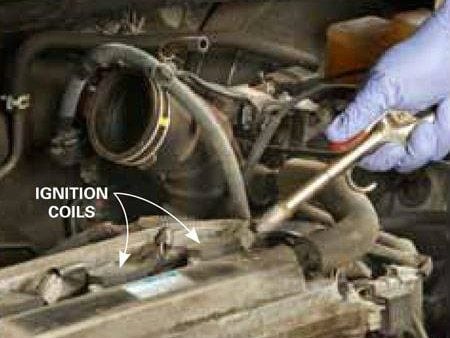
Remove Extras and Clean Your Work Area
Start by removing the plastic “vanity” cover (if equipped) and the air cleaner assembly from the top of the engine. Be sure to label any vacuum hoses you remove so you get them back in the right place. Then clean the top of a four-cylinder engine, or the banks on a “V” engine, before you remove other parts.
Blast compressed air around the ignition coils to prevent crud from falling into the cylinders. Then blow any remaining loose dirt off the engine before you set out your tools and new plugs.
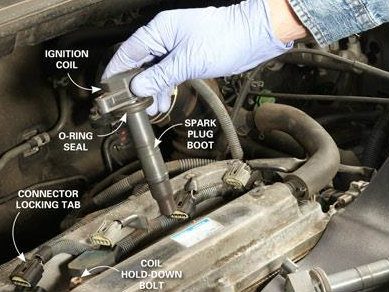
Remove the Ignition Coil and/or Boot
Disconnect the ignition coil electrical connector by depressing (or pulling up) on the locking tab. Then rock the connector off the coil. Next, remove the coil hold-down bolt and pull out the entire coil and boot assembly. Some COP systems have a detachable rubber boot and spring. If they don’t come out with the coil, retrieve them with needle-nose pliers and replace them with new parts. Then remove the old spark plug.
If your car doesn’t use COP ignition, simply pull the boots off the plugs.
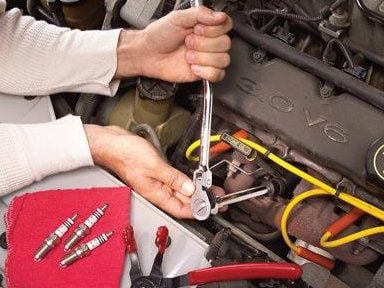
Unscrew the Plug
Blow away the dirt and crud that’s settled on and around the plug since it was installed. Slide the proper size spark plug socket over the plug. A swivel-head spark plug socket makes the job much easier. You’ll probably need an extension of some length to reach the plug. Rotate the plug counter-clockwise to loosen it.
Not all engines leave the plugs as accessible as shown here. The more compact the engine compartment, the harder it will be to get to the plugs. But all plugs can be removed.
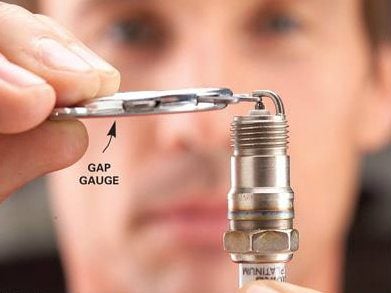
Gap the Plug
Always check the spark plug gap before installing it. Autolite expert Dave Buckshaw recommends using a wire-style gap gauge instead of the inexpensive variable-thickness “disc-style” gauge. They can bend the electrode off-centre or even break it off.
Slide the correct wire gauge between the electrodes. The wire should drag slightly between them. If the gap is too small, open it with the gap gauge. If the gap is too large, tap the side electrode lightly on a solid surface.
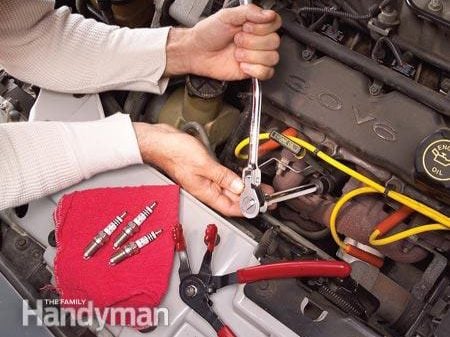
Install the New Plug
New spark plugs have an anti-corrosive coating on the threads, so just screw them in and use a torque wrench to tighten to the correct torque.
If you don’t have a torque wrench, go to the spark plug manufacturer’s website to find manual tightening techniques.
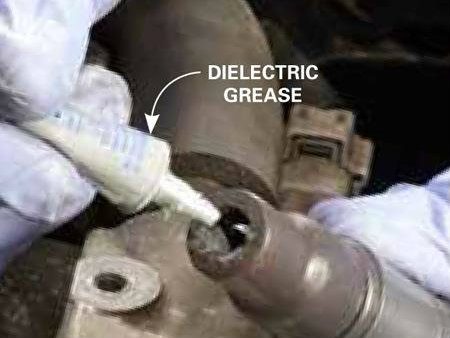
Lube the boot and button it up
Apply a thin coating of dielectric grease around the inside of the spark plug boot before reinstalling the coil. The grease prevents misfires and makes it easier to remove the boot in the future. Then reinstall the ignition coil, hold-down bolt and coil electrical connector. Finally, reinstall the air cleaner and vanity cover and fire it up. Enjoy the extra power and gas savings.
Follow the same procedure for non-COP ignition system boots.
Check out more do-it-yourself car maintenance tips!
Explore Reader’s Digest Cars.